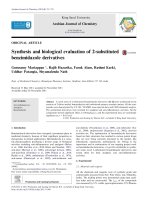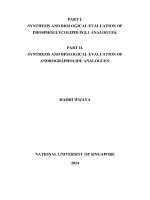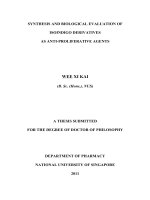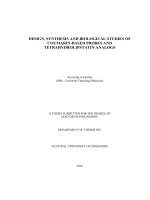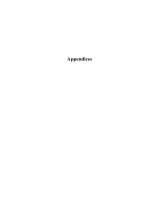Design, synthesis and biological evaluation of inhibitors of flavivirus NS2B NS3 protease
Bạn đang xem bản rút gọn của tài liệu. Xem và tải ngay bản đầy đủ của tài liệu tại đây (1.59 MB, 162 trang )
Design, Synthesis and Biological Evaluation of Inhibitors of
Flavivirus NS2B/NS3 Protease
Gao Yaojun
(B.Sc., Soochow University)
A THESIS SUBMITTED
FOR THE DEGREE OF DOCTOR OF PHILOSOPHY
DEPARTMENT OF CHEMISTRY
NATIONAL UNINVERSITY OF SINGAPORE
2009
ACKNOWLEDGEMENTS
First and foremost I offer my sincerest gratitude to my supervisor, Associate Professor
Lam Yulin, for her invaluable support, encouragement, supervision and useful
suggestions throughout my Ph.D. Her moral support and continuous guidance enabled
me to complete my work successfully. I am also highly thankful to my co-supervisor,
Dr. Cui Taian, Senior Lecturer in Singapore polytechnic for his encouragement and
effort and without him this thesis, too, would not have been completed.
I gratefully acknowledge the laboratory officers in CMMAC, Dept. of Chemistry,
Miss Tan Geok Kheng, Mdm Han Yanhui, Mdm Wong Lai Kwan and Mdm Lai Hui
Ngee for their assistance and technical support, and all others who have helped in one
way or another.
I deeply appreciate my group members, Fu Han, Kong Kah Hoe, He Rongjun, Gao
Yongnian, Che Jun, Ching Shi Min, Fang Zhanxiong, Wong Ling Kai, William Lin
Xijie and Sanjay Samanta, for all their help and encouragement during my research.
Furthermore, I would like to thank the staff at SP, Miss Ang Cuixia, Dr Puah Chum
Mok, Dr. Chen Gang and Dr. Liew Oi Wah, thank you for all the support given.
I am as ever, especially indebted to my parents and my sister for their love and
support throughout my life. Finally, I thank National University of Singapore for
awarding me a research scholarship to pursue my doctorate degree.
i
TABLE OF CONTENTS
TABLE OF CONTENTS i
SUMMARY v
LIST OF TABLES vii
LIST OF FIGURES viii
LIST OF SCHEME x
LIST OF ABBREVIATIONS xi
PUBLICATIONS xiv
Chapter 1: Introduction
1.1 Flavivirus 1
1.2 Flavivirus virion and viral life cycle 2
1.3 Flavivirus genome structure and polyprotein processing 4
1.4 Features of the structural and non-structural proteins 7
1.5 DEN/WNV NS2B/NS3 protease as drug target 13
1.6 Existing inhibitors of DEN/WNV NS2B/NS3 protease 15
1.6.1 Peptidic inhibitors 18
1.6.2 Nonpeptidic inhibitors 23
1.7 Objective of the our studies 26
Chapter 2: Biosynthesis of an Acyclic Permutant of Kalata B1 from a
Recombinant Fusion Protein with Thioredoxin
2.1 Introduction 27
2.2 Results and Discussion 29
2.2.1 Construction of expression vectors 29
ii
2.2.2 Expression and purification of fusion protein 30
2.2.3 Enterokinase cleavage and the H
2
O
2
effect 32
2.2.4 Isolation and purification 35
2.2.5 Characterization of recombinant ac kalata B1 36
2.2.6 Thermal stability studies 37
2.3 Conclusion 37
2.4 Experimental section 38
2.4.1 Synthetic peptides and oligonucleotides 38
2.4.2 Fusion protein expression and purification 38
2.4.3 Release of the target peptide by enterokinase cleavage 39
2.4.4 Purification of recombinant ac kalata B1 40
2.4.5 Mass spectrometric analysis of the target peptide 41
2.4.6 Thermal stability studies 41
Chapter 3: Design and disulfide bond connectivity-activity studies of a kalata
B1-inspired cyclopeptide against dengue NS2B/NS3 protease
3.1 Introduction 43
3.2 Results and Discussion 48
3.2.1 Design and oxidative refolding of cyclopeptide 1
48
3.2.2 Determination of disulfide bond connectivity in cyclopeptide
1
50
3.2.3 Inhibition of dengue NS2B-NS3 protease 54
iii
3.3 Conclusion 56
3.4 Experimental Section 57
3.4.1 Chemicals and synthetic peptides 57
3.4.2 Oxidative refolding of cyclopeptide 1 and purification of the
individual isomers
57
3.4.3 Mass spectrophotometric analysis of disulfide bond
connectivity in cyclopeptide 1
58
3.4.4 Inhibitory activity assay against DEN2 NS2b-NS3 protease 60
Chapter 4: Synthesis and biological evaluation of small molecule inhibitors of
West Nile Virus NS2B/NS3 Protease
4.1 Introduction 63
4.1.1 Chemistry 65
4.1.2 Biological test 68
4.2 Results and Discussion 70
4.2.1 SAR study 70
4.2.2 Kinetic analysis of inhibition by enantiomer 74
4.2.3 Preliminary molecular docking 76
4.3 Conclusion 77
4.4 Experimental Section 78
iv
Chapter 5: Synthesis of Pyrazolo[5,1-d][1,2,3,5]tetrazine-4(3H)- ones
5.1 Introduction 99
5.2 Results and Discussion 100
5.2.1 Solution-phase Synthesis 100
5.2.2 Solid-phase Synthesis 102
5.3 Conclusion 105
5.4 Experimental Section 105
5.4.1 Materials and methods 105
5.4.2 Experimental procedure 106
Chapter 6: References
117
Appendix
132
v
SUMMARY
This thesis is divided into two parts. The first part which is the main focus of the
thesis involves the design, synthesis and biological evaluation of inhibitors of Dengue
and West Nile virus NS2B-NS3 protease.
For the design of dengue NS2B-NS3 protease inhibitors, we were inspired by the
unique structural and diverse biological activities found in cyclotides to design
cyclopeptides as inhibitors of dengue virus protease. Firstly, we designed a new
approach to obtain some acyclic cyclotides based on the bacterial expression of a
thioredoxin-ac kalata B1 fusion protein and subsequent liberation of ac kalata B1 by
enterokinase cleavage of the precursor. Secondly, using the new approach and
chemical synthetic method, we prepared various kalata B1 analogues by varying its
amino acid sequence and found the two fully oxidized forms of a cyclopeptide
showed potent inhibition with K
i
value of 1.39 ± 0.35 and 3.03 ± 0.75 μM,
respectively. To our best knowledge, these were among the most potent peptide
inhibitors achieved for the dengue viral protease.
For the design of West Nile virus NS2B-NS3 protease inhibitors, initially, a library of
more than 100 compounds was screened for WNV NS3 protease inhibition assays by
high throughput screening (HTS). Through HTS, we found several “hits” that
inhibited the WNV NS2B/NS3 protease. Among these “hits” compounds, a
compound showed the best inhibition and was chosen for structure activity
vi
relationship (SAR) exploration on WNV NS3 protease inhibition assays. In the
studies, a potent, stable molecule with K
i
value of 1.82±0.58 μM was identified to be
an uncompetitive inhibitor. To our knowledge, this is the most potent compound
amongst the stable small molecule inhibitors of WNV NS2B-NS3 protease reported
so for.
The second part of this thesis involves the methodology development of the
solid-phase synthesis of pyrazolo[5,1-d][1,2,3,5]tetrazine-4(3H)-ones. In the
methodology, a one-pot reaction from 5-aminopyrazoles to the
pyrazolo[5,1-d][1,2,3,5] tetrazine-4(3H)-ones which provided the compounds in good
yields was demonstrated. A representative set of 16
pyrazolo[5,1-d][1,2,3,5]tetrazine-4(3H)-ones was prepared.
vii
LIST OF TABLES
Table 1.1
Characteristics and functions of flavivirus proteins 7
Table 1.2
Summary of peptidic inhibitors of NS2B/NS3pro 22
Table 3.1
Peptides designed as potential inhibitors to DEN2 NS2B/NS3
protease
47
Table 3.2
Fragments after NH
4
OH cleavage for assignment of disulfide bond
connectivity
52
Table 3.3
Fragments after trypsin cleavage for assignment of disulfide bond
connectivity of isomer 1C
54
Table 3.3
Inhibition of dengue NS2B-NS3 protease by isomers 1B and 1C
56
Table 4.1
Optimization of cyclization reaction to prepare compound 4-6
67
Table 4.2
WNV NS3 protease inhibitor analogues and their inhibition results 73
Table 4.3
The inhibition results of enantiomers from selected racemic
compounds
74
Table 5.1
Nitrile analogs and their reaction times 110
viii
LIST OF FIGURES
Figure1.1
Image of the flavivirus virion. 3
Figure 1.2
Schematic representation of flavivirus genome organization and
polyprotein processing
5
Figure 1.3
Nomenclature for peptide residues (P3-P3’) and their
corresponding binding sites (S3-S3’) in the enzyme
14
Figure 1.4
Crystal structures of WNV NS2B/NS3pro and predicted
substrate and membrane interactions
18
Figure 1.5
Non-peptidic inhibitors of DEN and WNV NS2B/NS3 proteases
and their inhibitory potencies
25
Figure 2.1
Construction of expression vectors 29
Figure 2.2
Expression and enterokinase-catalyzed cleavage of recombinant
thioredoxin- ackalata B1 fusion protein studied by SDS-PAGE
31
Figure 2.3
Time-dependent and hydrogen peroxide-dependent cleavage of
recombinant thioredoxin-ac kalata B1 fusion protein by
enterokinase
34
Figure 2.4
HPLC chromatogram and MS spectra of ac-kalata B1 35
Figure 3.1
Structure of Ciluprevir, a cyclic peptide inhibitor of HCV
NS3pro
44
ix
Figure 3.2
Schematic representation of a cyclotide (kalata B1) structure 46
Figure 3.3
Possible isomers of cyclopeptide 1
48
Figure 3.4
HPLC profiles 49
Figure 3.5
Inhibition of WNV by protease inhibitors 56
Figure 4.1
Structures and IC
50
values of WNV NS2B-NS3pro inhibitors
confirmed in the HTS
65
Figure 4.2
Uncompetitive mechanism of inhibition of WNV NS2B-NS3pro
by the (-) enantiomer of compound 4-6o
76
Figure 5.1
Library of synthesized pyrazolo[5,1-d][1,2,3,5]tetrazine
-4(3H)-ones 5-1a-p
105
x
LIST OF SCHEME
Scheme 1.1
Chemical form of aldehyde inhibitor in water 19
Scheme 3.1
Schematic representation of strategy 1 used for disulfide bond
connectivity determination
51
Scheme 3.2
Schematic representation of strategy 2 used for disulfide bond
connectivity determination
53
Scheme 4.1
Synthesis of compound 4-7
66
Scheme 4.2
Synthesis of compound 4-10 and 4-11
68
Scheme 5.1
Solution-phase Synthesis. 101
Scheme 5.2
SPS of Pyrazolo[5,1-d][1,2,3,5]tetrazine-4(3H)-ones 103
xi
LIST OF ABBREVIATIONS
δ
Chemical shifts
ac Acyclic
BCA Bicinchoninic acid
Boc t-Butoxycarbonyl
CDAP 1-Cyano-4-dimethyl-aminopyridinium tetrafluoroborate
CDC Centers for Disease Control and Prevention
DBU 1,8-Diazabicycloundec-7-ene
DEN Dengue virus
DHF Dengue hemorrhagic fever
DIEA Diisopropyl ethyl amine
DMA Dimethylacetamide
DMF Dimethylformamide
DMSO Dimethyl sulfoxide
DNA Deoxyribonucleic acid
DSS Dengue shock syndrome
DTT Dithiothreitol
E. coli Escherichia coli
EI Electron impact
ER Endoplasmic reticulum
ESI Electrospray ionization
FAB Fast atom bombardment
xii
HCV Hepatitis C virus
HIV Human immunodeficiency virus
HPLC High performance liquid chromatography
HTS High throughput screening
IC
50
Half maximal inhibitory concentration
IPTG Isopropyl-β-D-1- thiogalactopyranoside
JEV Japanese encephalitis virus
MALDI TOF Matrix Assisted Laser Desorption /Ionization- Time Of Flight
MS Mass spectrometry
MW Molecular weight
NEM N-Ethylmaleimide
NMR Nuclear magnetic resonance
PCR Polymerase chain reaction
PDB Protein Data Bank
RNA Ribonucleic acid
TRX Thioredoxin
SDS-PAGE Sodium dodecyl sulfate-polyacrylamide gel electrophoresis
SPS Solid-phase synthesis
TBE Tick-borne encephalitis virus
TCEP Tris(2-chloroethyl)phosphate
TGN Trans-Golgi network
THF Tetrahydrofuran
xiii
TLC Thin layer chromatography
TMSCl Trimethylsilyl chloride
UTR Untranslated region
Wang resin 4-Hydroxymethylphenoxy resin
WNV West Nile virus
YFV Yellow fever virus
xiv
PUBLICATIONS
1. Yaojun Gao, Taian Cui, Yulin Lam. Synthesis and biological evaluation of small
molecule inhibitors of West Nile Virus NS2B/NS3 Protease.( In preparation).
2. Yaojun Gao, Taian Cui, Yulin Lam. Synthesis and disulfide bond connectivity–
activity studies of a kalata B1-inspired cyclopeptide against dengue NS2B-NS3
protease. Bioorg. Med. Chem. 2010, 18, 1331–1336.
3. Yaojun Gao, Yulin Lam. Synthesis of Pyrazolo[5,1-d][1,2,3,5] tetrazine-4(3H)-
ones. J. Comb. Chem. 2010, 12, 69–74.
4. Taian Cui, Yaojun Gao, et al. Hydrogen peroxide enhances enterokinase-catalysed
proteolytic cleavage of fusion protein. Recent Pat Biotechnol. 2008, 2, 189-90.
5. Taian Cui, Yaojun Gao, et al. Efficient preparation of an acyclic permutant of
kalata B1 from a recombinant fusion protein with thioredoxin. J. Biotechnol. 2007,
130, 378-384
PATENT
1. Taian Cui, Chum Mok Paul, Yulin Lam, Yaojun Gao
. Conpounds for use as
anti-virus agents. Patent No. 10757sg28, Filling date: 17 Dec 2008.
1
Chapter 1 Introduction
1.1 Flavivirus
Flaviviruses (Latin flavus meaning yellow, because of the jaundice induced by yellow
fever virus) are a major cause of infectious disease in humans. The genus Flavivirus
contains more than 70 members
1,2
, including yellow fever virus (YFV), dengue virus
(DEN), West Nile virus (WNV), Japanese encephalitis virus (JEV), and tick-borne
encephalitis virus (TBE), etc. This number is increasing as more viruses are
discovered and will undoubtedly continue to increase for some time yet. Some
flaviviruses such as YFV, JEV, and TBE were first recognized because they caused
major human epidemics involving high fatality rates. Others, such as dengue virus,
cause about 50–100 million cases of dengue fever occurring in the tropical and
sub-tropical regions of the world and the infected cases exhibit a broad spectrum of
clinical symptoms ranging from being fully asymptomatic to causing life-threatening
conditions like dengue hemorrhagic fever (DHF) or dengue shock syndrome (DSS).
West Nile virus, another example, historically occurs in Africa, Europe, the Middle
East, Central Asia, and West. According to the report published by the Centers for
Disease Control and Prevention (CDC), from an outbreak occurred in the USA in
1999 to 2008, with largest ever WNV outbreaks occurring in 2002 and 2003, a total of
29,000 around cases of WNV infection, more than 1100 of whom died, had confirmed
infections with the virus (see:
Although licensed vaccines
3
are available for YFV, JEV and TBE, none have been
2
developed for other flaviviral diseases. Efforts for vaccine development for dengue
have been a continuous challenge for decades, the main issue being the inability of
vaccines to protect simultaneously against all four antigenically distinct serotypes. A
further barrier to vaccine development is the sporadic nature of infections caused by
agents such as WNV, JEV and TBE, which could only be completely prevented by
carrying out universal immunization across huge geographic regions. In the absence
of vaccines, drugs for specific therapy are needed, but no antiviral medications have
been approved for use against the flaviviruses.
1.2 Flavivirus virion and viral life cycle
The mature flavivirus virions are smooth and spherical, with a diameter of 500 Å
4
(Figure 1.1). They possess an icosahedral nucleocapsid (NC) of approximately 30 nm
consisting of single-stranded positive-sense RNA genome and several copies of a
small, basic capsid protein. The nucleocapsid is surrounded by a lipid envelope in
which two envelope proteins are embedded: the envelope protein (E) and the
membraneprotein (M) or its precursor M
5
. Intracellular virions, which only contain
prM, as well as released extracellular virons, which predominantly contain M protein,
have been described. In comparison with intracellular particles, extracellular particles
have a greater infectivity than those remaining intracellular. For West Nile virus, the
specific infectivity of intracellular virus was demonstrated to be 60-fold lower than
the one of extracellular particles
6
. Recently, the structure of immature and mature,
3
pr-M containing YFV
7
and dengue particles
7,8
was determined to 25 Å and 24 Å
resolutions, respectively, by cryoelectron microscopy and image reconstruction
techniques. The structure suggests that flaviviruses employ a fusion mechanism in
which the distal β barrels of domain II of the glycoprotein E are inserted into the
cellular membrane
8
.
Figure 1.1 Image of the flavivirus virion.
In the flavivirus replication cycle
4,9
, virions bind to cell-surface attachment molecules
and receptors and are internalized through endocytosis. In the low pH of the
endosome, viral glycoproteins mediate fusion of the viral and cellular membranes,
allowing disassembly of the virion and release of its RNA into the cytoplasm. The
viral RNA is translated into a polyprotein that is processed by viral and cellular
proteases. Genome replication occurs on intracellular membranes. Virion assembly
occurs on the surface of the endoplasmic reticulum (ER) membrane. Capsid protein
and viral RNA are enveloped by the ER membrane and its embedded glycoproteins to
form immature virus particles, which are then transported through the secretory
4
pathway. In the low pH of the trans-Golgi network (TGN), prM is cleaved by furin.
Mature virions are then released into the cytoplasm.
1.3. Flavivirus genome structure and polyprotein processing
The genomic RNA of flavivirus is infectious. It consists of a single stranded RNA of
positive polarity with length of approximately 11kb
10
. The genome encodes one large
polyprotein which is flanked by a short 5′ untranslated region (UTR) and 3′ UTR
11
(Figure 1.2) which have secondary structures that are essential for the initiation of
translation and for replication
12
. The 5′ UTR is about 120 nucleotides in length and
the 3′ UTR comprises about 500 nucleotides. Similar to eukaryotic RNAs, the
flaviviral genome contains a 5′ cap structure, but the 3′ end lacks a poly-A tail.
Translation of the genome by the host cell machinery produces a polyprotein
comprising the viral structural and non-structural proteins that are required for
replication and assembly of new virions.
The large polyprotein is cleaved co- and posttranslationally by host and viral
proteases to release the single viral protease (Figure 1.2 and Table 1.1). The
structural proteins are encoded from the 5′-terminal quarter of the genome whereas
the remaining two-thirds encode the nostructural proteins. The order of the proteins
within the polyprotein is NH
2
-C-prM(M)-E-NS1-NS2A-NS2B-NS3-NS4A-NS4B-
NS5-COOH. In addition, two small hydrophobic proteins are released from the
5
polyprotein, one is derived from the C-terminus of the anchored capsid protein after
cleavage the mature capsid is released
13
. The second one represents a small fragment
between the NS4A and the NS4B protein and is called 2K based on its predicted
size
14
.
Structural Nonstructural
Flavivrus RNA genome and polyprotein
Postive-strand RNA genome
C prM E NS1 2A 2B 3 4A 4B 5
Mpr
2Aa
◆◆ ◆
5′UTR 3′UTR
Cap
translation
Furin
◆
NS2B/NS3 Protease
Signalase
? Unknown protease
?
◆
Structural Nonstructural
Flavivrus RNA genome and polyprotein
Postive-strand RNA genome
C prM E NS1 2A 2B 3 4A 4B 5
Mpr
2Aa
◆◆ ◆
5′UTR 3′UTR
Cap
translation
Furin
◆
NS2B/NS3 Protease
Signalase
? Unknown protease
?
◆
Figure 1.2 Schematic representation of flavivirus genome organization and
polyprotein processing. Top, the flaviviral genome with the structural and
nonstructural proteins coding region, the 5′ UTR with 5′ cap structure and the 3′ UTR
with the potential 3′ secondary structure are shown. Below, the mature flaviviral
proteins generated by polyteolytic processing of the polyprotein are demonstrated.
Gray boxes represent the structural proteins (capsid (C), precursor membrane (prM)
and envelope (E)), white boxes represent the nonstructural proteins (NS1, NS2A,
NS2B, NS3, NS4A, NS4B, NS5). In addition, two small hydrophobic fragments are
cleaved from the polyprotein (black bars). Cleavage sites for viral serine protease ( ),
the host signalase (◆), furin(↓), or unknown protease ( ? ) are indicated.
The structural proteins prM and E as well as the following nonstructural protein NS1
are translocated into the endoplasmic reticulum. Cleavages that generate the
N-termini of prM and E as well as the C-terminus of E are mediated by host cell
6
signal peptidase
15
. In contrast, the capsid protein remains in cytoplasm. Processing to
generate the C-terminus of the mature capsid proteins is performed by the viral
NS2B-NS3 protease
13
. This cleavage is a prerequisite for efficient processing to
generate the N-terminus of prM by the signal peptidase
16
. Therefore, mutations that
abolish cleavage to produce the C-terminus of the mature capsid proteins also prevent
the production of infectious particles
16
. Furthermore, mutations that enhance signalase
cleavage to generate the N-Terminus of prM are lethal for virus production
17
.
The protease responsible for processing at the NS1-2A site is assumed to localize in
endoplasmic reticulum but has not been identified yet. However, for dengue virus it is
known that the eight last amino acids of NS1 are required for cleavage at the NS1-2A
site
18,19
. Processing in the remaining nonstructural protein region is mainly mediated
by the NS2B-NS3 protease
15
. This viral protease is responsible for cleavage at the
NS2A/2B, NS2B/3, NS3/4A, NS4A/2K, and NS4B/5 sites. For YFV, additional
cleavage site in the C-terminal region of NS2A has been described (NS2Aa site)
20,21
.
Similar to dengue virus, for which a minor cleavage within NS3 has been described
22
.
The viral serine protease cleavage sites usually consist of two basic amino acids
followed by an amino acid with a short side chain. In the case of DEN or WNV the
cleavage sites usually consist of RR↓G/S (Table 1.1)
15,23
. Little variation is observed
for the NS2Aa site (QKT) and the NS4A-2K site (QRS) in YFV. In contrast to the
majority of cleavage events in the NS region, the N-terminus of NS4B is generated by
7
host cell signal peptidase, but prior cleavage at the NS2A/2K site is required
14
. Other
than the case just mentioned, processing at other sites within the NS region does not
take place in an obligate order.
Table 1.1 Characteristics and functions of flavivirus proteins
Protein
MW
Cleavage site at N-terminus,
protease responsible for
cleavage
Function/enzymatic activity
C 11 kD [vir C/anchC] cleavage site:
RR↓S, NS2B-NS3 Protease
Capsid protein,
Interaction with genomic RNA
prM/M 26 kD/8 kD PrM: TGG↓V, Signalase
M: ARR↓A, Furin
Membrane protein
E
53-54 kD
AYS↓A, Signalase
Envelope protein,
Hemagglutination activity,
Mediates binding to cell surface
NS1 46 kD VGA↓D, Signalase RNA replication,
Role in neurovirulence
NS2A 24 kD VTA↓G, Unknown Role in production of infectious
particles
NS2B 14 kD RR↓S, NS2B-NS3 Protease Cofactor of viral serine protease
NS3
70 kD
RR↓S, NS2B-NS3 Protease
Trypsine-like serine protease,
RNA helicase,
RNA triphosphatease
NS4A 16 kD RR↓G, NS2B-NS3 Protease Presumably role in RNA
replication
NS4B 28 kD VAA↓N, Signalase Presumably role in RNA
replication
NS5 103 kD RR↓G, NS2B-NS3 Protease RNA-dependent RNA
polymerase, Methytransferase
1.4 Features of the structural and non-structural proteins
The capsid (C) protein
The C protein which contains a conserved hydrophobic domain is a highly basic
8
protein of ≈11 kD. The hydrophobic domain is cleaved from mature C by the viral
serine protease
24
. Owing to the basic character, C protein binds strongly to RNA,
together with the viral RNA, several copies of the C protein form the nucleocapsid
(NC). Analysis of purified C protein expressed in Escherichia coli revealed that it is
largely alpha-helicl and forms dimers
25
. It is not yet clear how C protein dimers are
organized within nucleocapsids, but interaction with RNA can induce isolated C
protein dimers to assemble into nucleocapsidlike particles
26
.
The membrane (prM/M) protein
The glycoprotein precursor of the mature M protein (≈8 kD), prM (≈26 kD), is
translocated into the endoplasmic reticulum (ER) by the C-terminal hydrophobic
domain of C. Signal peptidase cleavage is delayed, however, until the viral serine
protease cleaves upstream of the signal sequence to generate the mature form of C
protein
13,24,27
. The N-terminal region of prM contains one to three N-linked
glycosylation sites
11
and six conserved cysteine residues, all of which are disulfide
linked
28
. The prM protein folds rapidly and assists in the proper folding of E
protein
29,30
. A major function of prM is to prevent E from undergoing acid-catalyzed
rearrangement to the fusogenic form during transit through the secretory pathway
31,32
.
The conversion of immature virus particles to mature virions occurs in the secretory
pathway and coincides with cleavage of prM into pr and M fragments by the
Golgi-resident protease furin or a related enzyme
33
.
9
The envelope (E) protein
The E protein (≈53 kD), the major protein on the surface of flavivirus virions,
mediates receptor binding and membrane fusion. E is synthesized as a type I
membrane protein containing 12 conserved cysteines that form disulfide bonds
34
, and,
for some viruses, E is N-glycosylated
35,36
. As mentioned, proper folding, stabilization
in low pH, and secretion of E depends on coexpression with prM
29,30
. The native form
of E folds into an elongated structure rich in β-sheets and forming head-to-tail
homodimers that lie parallel with the virus envelope
4,37
. Each E protein subunit is
composed of three domains: I, which forms a β-barrel; II, which projects along the
virus surface between the transmembrane regions of the homodimer subunits; and III,
which maintains an immunoglobulin-like fold.
The NS1 protein
The NS1 protein (≈46 kD) is translocated into the ER during synthesis and cleaved
from E protein by host signal peptidase, whereas an unknown ER-resident host
enzyme cleaves the NS1/2A junction.
38,39
NS1 is largely retained within infected cells
but can localize to the cell surface and is slowly secreted from mammalian cells
40
.
NS1 contains two or three N-linked glycosylation sites and 12 conserved cysteines
that form disulfide bonds
41-43
. NS1 has an important unclear role in RNA replication.
It localizes to sites of RNA replication
44,45
, and mutation of the N-linked
glycosylation sites in NS1 can lead to dramatic defects in RNA replication
46
and virus


